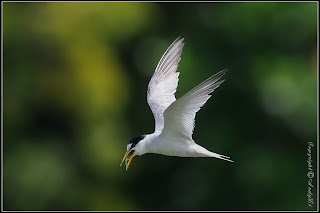Islands, sandbanks and fortified bridge over the Loire at La Charité-sur-Loire
The river is also regarded as Europe's last wild river. The riverine landscape is highly dynamic, with erosion taking place, new channels and oxbow lakes forming, and islands and sand banks shifting. Wildlife interest is high, with migrating salmon and birds, a wealth of plantlife and even European Beavers, reintroduced here in 1974. We planned to take a couple of days exploring along the river to my favourite part of the valley - the Sologne, near Blois.
Little Tern (photo by Andy Li via Creative Commons)
Heading north from La Charité-sur-Loire, we were straight away into the Val-de-Loire Nature Reserve. From the D7, we explored two viewpoints on dead-end roads in La Chapelle-Montilard, the first in the village of Passy and the second on Vauvrette road. The first revealed little but the river and farmland at Vauvrette proved far more interesting. A stroll along the tarmac riverside track, the lève de Loire, brought us Sand Martins, Marsh Harrier and a steady stream of feeding Little Terns up and down the river. The wooded fringes of the farmland had Red-backed Shrike, Cuckoo, Kestrel and Buzzard.Heading north, we stayed as close to the river as possible, mostly using smaller roads. We stopped at a few other viewpoints - I liked the areas near Saint-Satur (great views from the bridge on the D2) and Cosne Cours-sur-Loire. At one of the viewpoints, we found a very large, very run-over snake; it was difficult to tell, but I'm guessing it was a non-venomous Aesculapian Snake.
Photo by Anabis via Creative Commons
We didn't have an overnight stay planned but we chanced upon a fantastic campsite at Saint-Père-sur-Loire. The Hortus group site, Le Jardin de Sully, was a lovely family site with good facilities - including a small pool and table tennis - but most importantly for us it had a grassy riverside tent section with a stunning view of the river towards the town of Sully-sur-Loire on the opposite bank. Heather and I spent the evening cooking and relaxing with the binoculars close at hand to watch the birds along the river: a Serin sang in a nearby tree, a Hoopoe flew along the bank and a Little Egret flapped lazily upstream. Even better, we awoke the following morning to the high-speed babbling song of the Melodious Warbler in the tree next to our tent!
View from Le Jardin de Sully campsite towards Sully-sur-loire
From Saint-Père-sur-Loire, we headed slightly north and away from the river itself towards the Forêt d'Orléans. This vast wooded area - including the largest state forest in France - is also extremely flat and, combined with the impermeable soil, this has encouraged creation of an abundance of ponds and other wetlands, although the forest has been significantly drained in parts since the nineteenth century. Mainly oak and Scots Pine, the forest is home to Booted Eagle, Goshawk, Buzzard, Honey Buzzard, Black Woodpecker, Middle Spotted Woodpecker, Woodlark, Dartford Warbler, Nightjar, Golden Oriole, Western Bonelli's Warbler and Hawfinch. Wild Boar, Red Deer, Roe Deer, Red Squirrel are also present and Marsh Frogs (the largest frog native to Europe) can often be heard as well as seen in the wetter areas. The extensive forest rides are very attractive to butterflies and Glanville Fritillary, Marsh Fritillary, Small Pearl-bordered Fritillary, Swallowtail and Wood White may be seen.
In addition, after an absence of more than 40 years, Ospreys returned to breed on the lakes in the forest - one of the few places on the French mainland where they do so - and today there are around 22 pairs. We headed to the observatory on Étang de Ravoir. Halfway between the towns of Les Bordes and Ouzouer-sur-Loire on the D952, a gravel forest track heads north into the forest; there are clear Observatoire signs at the entrance. After a couple of kilometres there is a car park and a well-signed route through the woods to the hide which only takes a few minutes.
Osprey at nest (Photo by Shanthanu Bhardwaj via Creative Commons)
When we arrived, the female Osprey was on the nest and we had good views with the binoculars from the hide. A Grey Heron was fishing and Cormorants diving in the lake, otherwise things were relatively quiet. After contentedly watching the Osprey for a little longer, we headed back to the car, enjoying the woods a little more this time, especially the ponds and their dragon and damselflies. We stopped for another walk in the forest near Les Bordes and were rewarded with a singing Nightingale, a flyover Cuckoo and circling Buzzard.
With more camping beckoning in the Sologne, we decided to spend the night in the dry in Orléans, the ancient city that is capital of the Loiret department and the Centre region. Dating back to Gallic and Roman times, Orléans' strategic importance as a crossing point over the river made it, alongside Paris and Rouen, one of the three richest cities in medieval France and it was here in 1429 that Joan of Arc won her first major military victory in the Hundred Year's War between France and England.
 We stayed at the charming and well-located Hôtel de l'Ambeille and wandered down to the Gothic cathedral and outstanding Fine Arts Museum. After a stroll down by the riverside, we had an excellent dinner at La Petite Marmite in the old quarter.
We stayed at the charming and well-located Hôtel de l'Ambeille and wandered down to the Gothic cathedral and outstanding Fine Arts Museum. After a stroll down by the riverside, we had an excellent dinner at La Petite Marmite in the old quarter.Joan of Arc statue, Place du Martroi, Orléans
(photo by Joachim Fenkes via Creative Commons)






